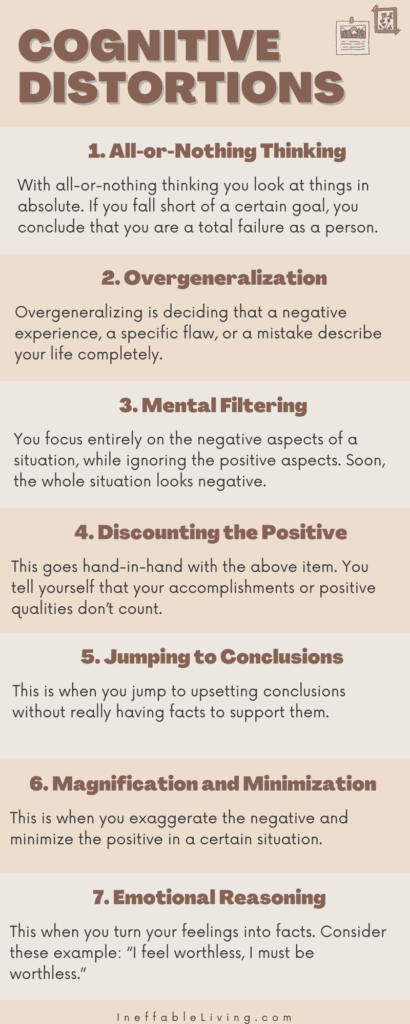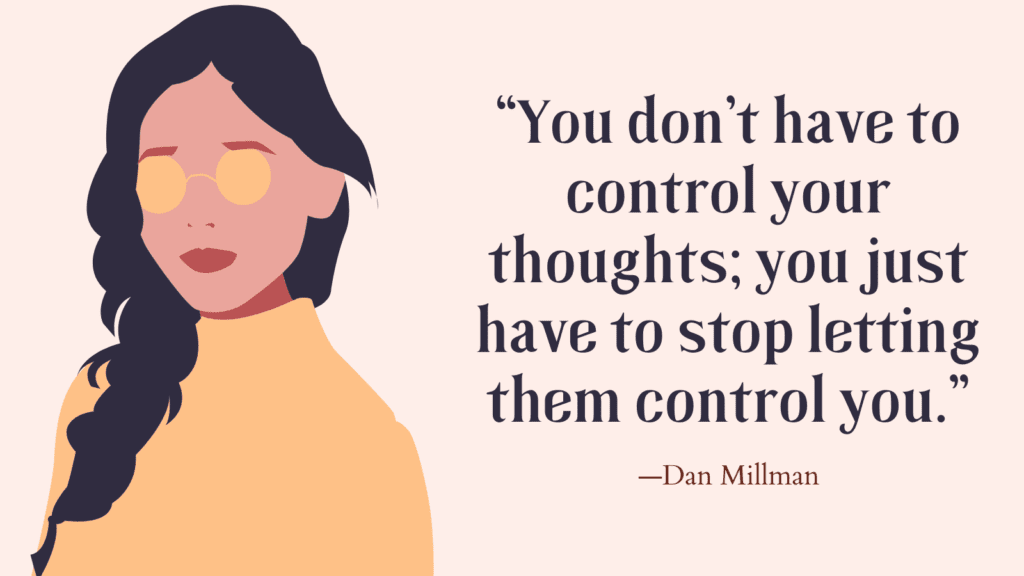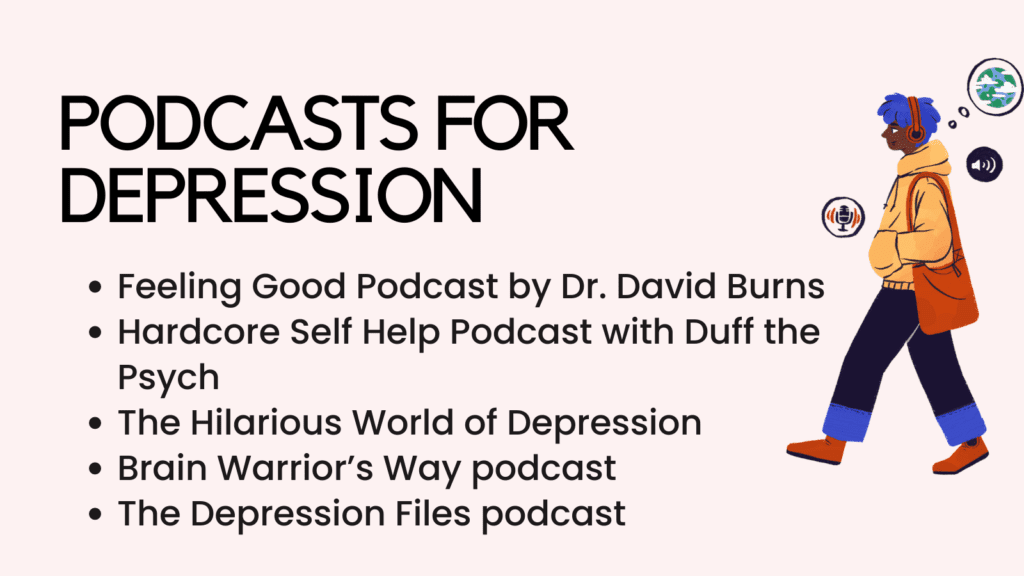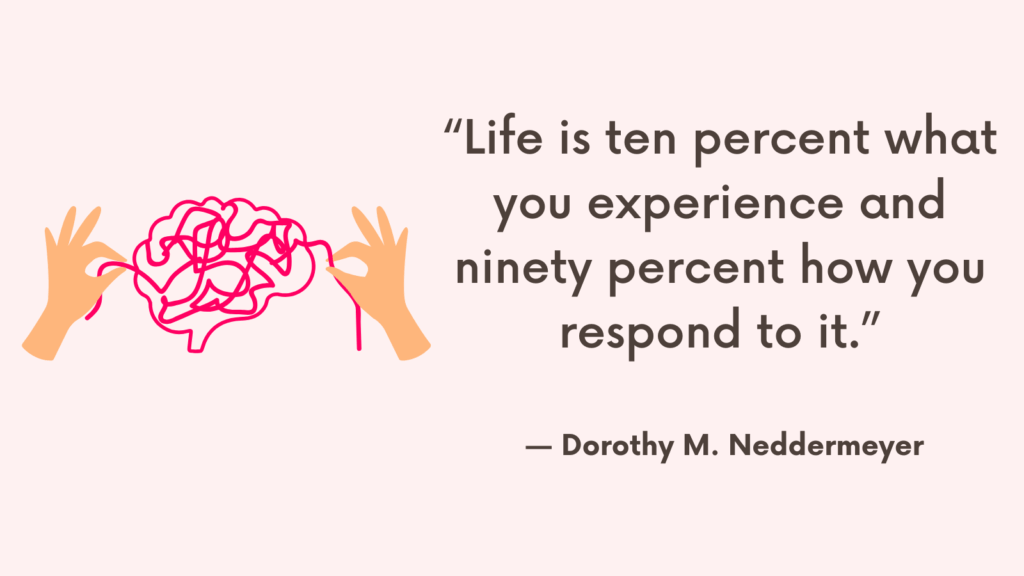Today, you’ll discover what causes cognitive distortions, top common examples of cognitive distortions you may be engaging in and how to challenges these thinking styles and reframe them.
What Is a Cognitive Distortion?
Cognition is a fancy word for a thought. It’s the way you interpret everything happening around you. These thoughts create your feelings.
Cognitive distortions, unhelpful thinking styles, or thinking errors are twisted and misleading ways of thinking about yourself and the world.
They don’t reflect reality and can even cause anxiety, depression, and other mental health issues.
What Causes Cognitive Distortions?
Cognitive Distortions do not have a single root cause.
However, a number of studies suggest that cognitive distortions can be caused by depression.
One 2018 research, found that cognitive distortions are more commonly seen in people with depression than those without.
Another international 2020 study suggests that negative thoughts are a “hallmark feature” of depression.
But cognitive distortions can also be prevalent in those who suffer from anxiety, and other mental illnesses.
There are also several factors that could trigger cognitive distortions:
- Social or cultural expectations,
- One’s beliefs, and moral values whether learned or passed on through generations,
- Genetics, and personality traits, such as resilience, persistence, and attitude,
- One’s ability to self regulate their emotions,
- Severe psychological trauma suffered as a child, such as emotional, physical, or sexual abuse,
- Feelings of inadequacy, low self-esteem, anxiety, anger, or loneliness,
- Social disadvantage, poverty or debt.
Related: Negative Core Beliefs List (& 8 Tips On How To Challenge Them)
10 Common Examples of Cognitive Distortions
Below are ten of the most common cognitive distortions:
1. All-or-Nothing Thinking
With all-or-nothing thinking you look at things in absolute. If you fall short of a certain goal, you conclude that you are a total failure as a person.
This unreasonable way of thinking can make life miserable because you feel like nothing most of the time.
The truth is black-and-white extremes rarely exist. Things are rarely completely horrible or absolutely perfect.
2. Overgeneralization
Overgeneralizing is deciding that a negative experience, a specific flaw, or a mistake describe your life completely. Or you might generalize the way you’re feeling right now.
If you were rejected by someone you loved, you might tell yourself that you’re “unlovable” and that you’ll end up alone forever.
You decide that a negative experience describe your life completely. You’re overgeneralizing from specific failure or negative experience to your entire self and from that moment to your entire future.
A healthy optimist would tell himself something like “Some people don’t approve of me, but some other people do.” He would find ways to improve situations and notice what’s going well.
3. Mental Filter
You focus entirely on the negative aspects of a situation, while ignoring the positive aspects. Soon, the whole situation looks negative.
Examples of mind filtering could go along these lines: “How can I feel good for the rest of the day now that I have been criticized?” or, “How can I enjoy my life when my children have problems?” or, “How can I enjoy my meal when the steak is burnt?”
Related: Best 10 Intrusive Thoughts Books
4. Discounting the Positive
This goes hand-in-hand with the above item. You tell yourself that your accomplishments or positive qualities don’t count.
For example, if someone compliments your work, you might reply, “Oh, it was really nothing. Anyone could do that.” Instead of just saying “Thanks,” and thinking to yourself that you deserve special credit for doing this difficult job, you insist your own positive qualities and success are just “average”.
Or you might notice how successful or attractive other people are and overlook their flaws.
Related: 10 Powerful Ways to Build Your Resilience
5. Jumping to Conclusions
This is when you jump to upsetting conclusions without really having facts to support them. This can take two forms:
Fortune Telling – this is when you make disturbing prediction about your future. This usually triggers feeling of hopelessness and sometimes even leads to suicidal thoughts.
If you’re feeling down, you may tell yourself that things will never change and that you’ll always feel this way.
Mind Reading – this is when you jump to conclusions regarding others thoughts and feelings without any clear evidence. This can cause social anxiety and lead to isolation.
For example, when you find yourself at a social gathering, you might tell yourself that other people are going to see how awkward you are, are going to judge you and be uninterested in whatever you might say. You might even convince yourself that everyone else is confident and relaxed, that no one else ever struggles with insecurities.
6. Magnification and Minimization
This is when you exaggerate the negative and minimize the positive in a certain situation.
Magnification can cause anxiety and panic attacks since it makes you greatly exaggerate danger.
For example, people who are afraid of flying would magnify the actual danger of dying in a plane crash and wrongly believe that it’s incredibly risky to fly, even though the annual risk of being killed in a plane crash for the average American is about 1 in 11 million while the annual risk of being killed in a motor vehicle crash for the average American is about 1 in 5,000. (1)
Minimization is when you tell yourself that something isn’t important – when it is.
For example, you might work out for 15minutes and simply think to yourself that it doesn’t count since some people spend hours in the gym, when in fact your regular workout does count and is making you a healthier person.
Related: Best 10 Books For Social Anxiety
7. Emotional Reasoning
This when you turn your feelings into facts. Consider these example: “I feel worthless, I must be worthless,” or, “I feel like I’m on the verge of a nervous breakdown, so I must be in real danger.”
Because your thoughts are negative sometimes, your feelings can be misleading. This is why your feelings do not always reflect reality.
Related: Are You Extra Sensitive? 9 Steps You Can Take Today To Reclaim Control Over Your Emotions
8. Should Statements
This is when you criticize yourself or other people using shoulds and shouldn’ts. There different types of should statements:
Self-Directed Shoulds – not living up to our self-imposed standards leads to feelings of guilt and even shame (“I shouldn’t have said that!”).
Other- Directed Shoulds – when others don’t meet our expectations, we end up feeling angry and frustrated. This also can lead to conflict and arguments with others (“She shouldn’t feel that way”).
World-Directed Shoulds – when the world doesn’t meet your expectations, this leads to frustration and anger.
Hidden Shoulds – even though they’re not expressed explicitly, they’re implied by your negative thoughts and feelings (by beating yourself up when you make a mistake, you’re telling yourself that you should be perfect).
Related: Top 20 Practical Ways to Overcome Toxic Perfectionism (& Get Things Done
9. Labeling
Labeling is when you try to capture the “essence” of yourself or someone else with a label. It is an extreme form of overgeneralization.
For example, you might call yourself “stupid” or “loser” instead of saying, “I made a mistake.”
Labeling distracts you from what’s important. You use all your energy ruminating about how bad you are, instead of pinpointing your mistake so you can learn from it and grow.
Related: Self-Abandonment: What Is It & How To Get Back In Touch With Yourself
10. Self-Blame and Other-Blame
This is when you find fault in yourself or others instead of trying to identify the real causes of the problem and solve it.
Self-Blame – this is when you blame or beat up on yourself for something you weren’t entirely responsible for.
Other-Blame – this is when you blame others while overlooking how you might have contributed to the problem.
Related: How To Manage Your Anger In Healthy, Effective Ways?

Challenging Cognitive Distortions Worksheet PDF

How to Challenge Cognitive Distortions?
#1. Recognize And Isolate The Thought
Absolute words, such ‘always’ or ‘never’ are usually a clue indicating that you’re having a cognitive distortion going on.
Other strong, negative words like, ‘hate,’ ‘stupid’ or ‘loser,’ directed at yourself can also indicate cognitive distortion.
Write the thought down and assess how paralyzing it is.
Related: How To Stop Self-Critical Thoughts Using These Top 10 Techniques
#2. Ask Yourself: Is It Reasonable?
Ask yourself: “If a friend said that about himself, would I agree or disagree?”
If the thought is reasonable
If the thought is truly reasonable, it’s probably not a distortion.
Take responsibility for whatever it is that caused the thought and the resulting bad feeling and do something about it.
If you can’t do anything about it now, let it go.
For example, you might have said something mean to a friend and hurt their feelings. Is it reasonable to think that you’re a horrible person? No, but it’s reasonable to feel remorse.
You need to take responsibility for hurting your friend, apologize, promise never to do it again, and let it go.
Related: How To Do Thought Work In 3 Simple Steps
If The Thought Is Unreasonable
#3. What Kind of Cognitive Distortion Is It?
All or nothing thinking? Overgeneralization? Labeling?
Once you have the distortion labeled, you’ll be able to catch yourself when you start having again even in a different context.
#4. Challenge The Thought: Questions to Challenge Congnitive Distortions
To reframe a cognitive distortion, answer the following questions:
· What evidence do I have that what I believe is actually true?
· Do I know for certain that the worst will happen?
· Is there another possible explanation for that person’s behavior that isn’t about me?
· Am I confusing a thought with a fact?
· Am I falling into a thinking trap (e.g., catastrophizing or overestimating danger)?
· What would I tell a friend if he/she had the same thought?
· Am I 100% sure that ___________will happen?
· How many times has __________happened before?
· Is __________so important that my future depends on it?
· If it did happen, what could I do to cope with or handle it?
· Am I condemning myself as a total person on the basis of a single event?
· Am I concentrating on my weakness and forgetting my strengths?
· Am I blaming myself for something which is not really my fault?
· Am I taking something personally which has little or nothing to do with me?
· Am I assuming I can do nothing to change my situation?
#5. What Would You Tell a Dear Friend?
If you find it hard to find a more reasonable thought to replace the distorted one, ask yourself what would you tell a friend in the same position having the same thought? Say it to yourself!
#6. Repeat As Needed.
Breaking distorted cognitive patterns doesn’t happen overnight – it takes practice.
However, the more you do it, the less prone you become to have distorted thoughts.


References
- Portions of this article were adapted from the book Feeling Good: The New Mood Therapy, © 1999 by David D. Burns. All rights reserved.
- Cognitive Distortions, Humor Styles, and Depression – PMC (nih.gov)
- Cognitive Distortions: Unhelpful Thinking Habits – Psychology Tools



